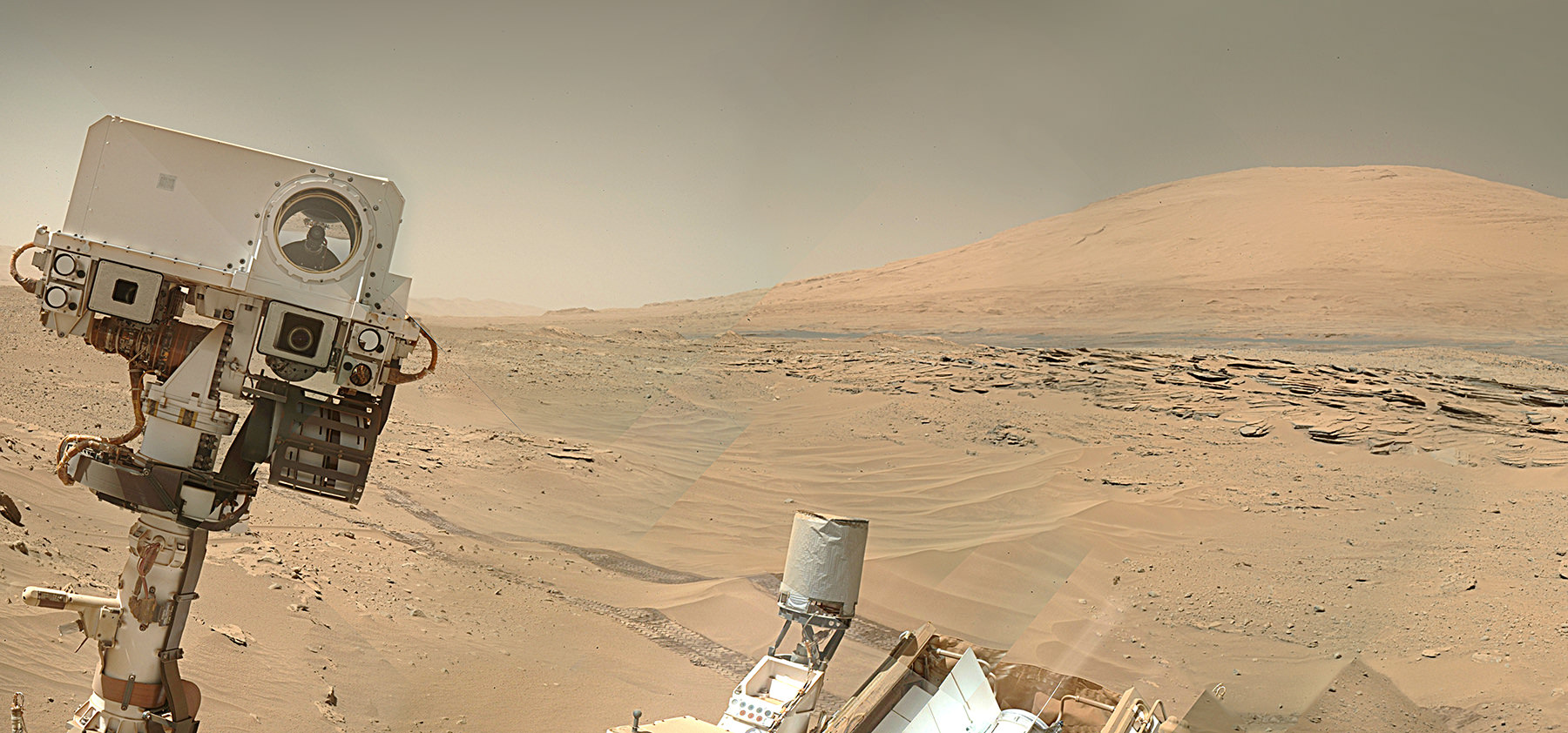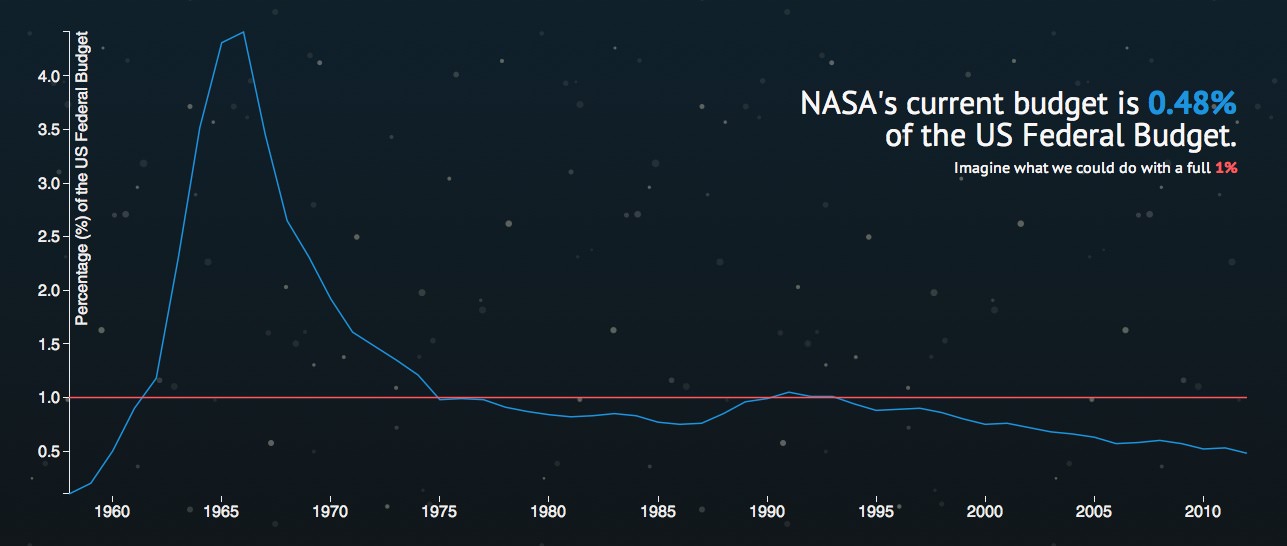Host: Fraser Cain (@fcain)
Guests: Morgan Rehnberg (cosmicchatter.org / @cosmic_chatter), Nancy Atkinson (@Nancy_A)
Continue reading “Weekly Space Hangout – May 2, 2014: Gas Clouds & Photobombs”
Court Injunction Blocks Russian Engine Purchase by ULA for US National Security – Win for SpaceX Yields Uncertainty
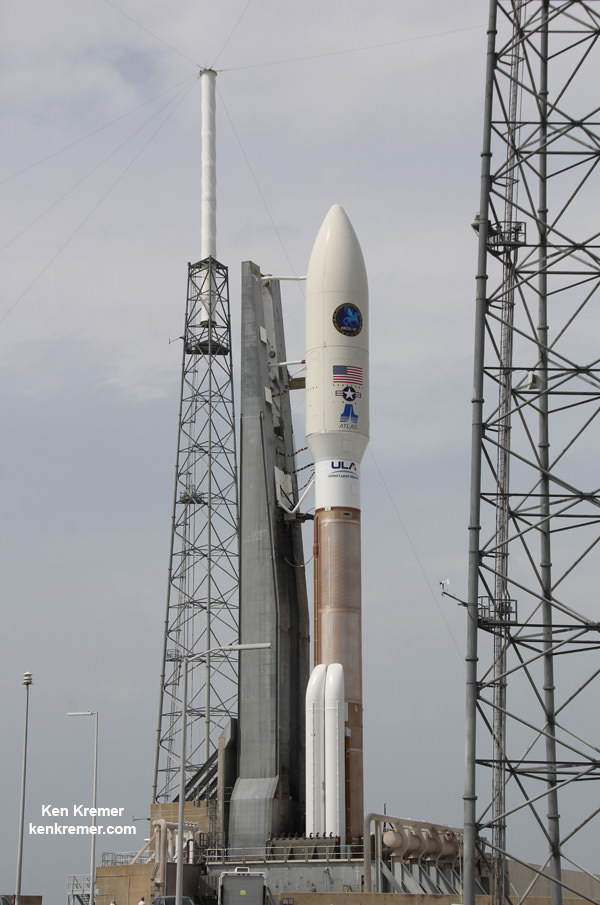
United Launch Alliance Atlas V rocket – powered by Russian made RD-180 engines – and Super Secret NROL-67 intelligence gathering payload poised for launch at Space Launch Complex 41 at Cape Canaveral Air Force Station, FL, in March 2014. Credit: Ken Kremer – kenkremer.com
Story updated[/caption]
A US Federal Court has now issued a preliminary injunction that blocks the purchase and importation of Russian rocket engines by United Launch Alliance (ULA) for its Atlas V rocket used in National Security launches for the US Air Force after a filing by SpaceX. But what are the implications?
The US Federal Court of Federal Claims order was issued late Wednesday, April 30, by US Judge Susan G. Braden of the US Court of Federal Claims. The court order is in response to a protest filed by SpaceX against ULA and the US Air Force relating to the uncontested $11 Billion “block buy” launch contract purchase in December of 36 rocket cores for US National Security launches and is also related to US sanctions imposed after Russia’s recent actions in Ukraine and seizing and annexing the Crimea.
The temporary injunction marks a big win for SpaceX but immediately throws future National Security spy satellite and NASA science launches into uncertainty and potential disarray as I reported previously – here and here.
As I posted here last Friday, April 25, SpaceX CEO Elon Musk declared his firms intent to file suit against ULA and the Air Force on Monday, April 28 to break the launch monopoly.
Judge Braden’s injunction followed barely two days later.
Musk said the recent ‘block buy’ launch contract was unfair in blocking SpaceX from competing for launches of surveillance satellites, would cost taxpayers billions of extra dollars in coming years and should be recompetited.
“The national security launches should be put up for competition and they should not be awarded on a sole source, uncompeted basis,” Musk said at the April 25 briefing at the National Press Club in Washington, DC.

ULA quickly vowed today that they will respond to resolve the injunction and further stated that “This opportunistic action by SpaceX … ignores the potential implications to our National Security.”
Federal Judge Braden’s order specifically states the following; “The preliminary injunction prohibits the United States Air Force and United Launch Alliance, from making any purchases from or payment of money to NPO Energomash or any entity, whether governmental, corporate or individual, that is subject to the control of Deputy Prime Minister Rogozin.”
“IT IS SO ORDERED,” wrote Braden.
The engines at the heart of the Federal preliminary injunction are the RD-180 liquid fueled engines which power ULA’s Atlas V rocket and are manufactured in Russia by NPO Energomash – which is majority state owned by the Russian Federation and subject to the control of Russian Deputy Prime Minister Rogozin, who is specifically named on the US economic sanctions target list.
In response, Rogozin said that sanctions could “boomerang” against the US space program. He said that perhaps NASA should “deliver their astronauts to the International Space Station using a trampoline.”
Thanks to the utter folly of US politicians in shutting down the Space Shuttle program before a replacement crew vehicle was available and repeatedly slashing NASA’s commercial crew budget, American astronauts are now 100% dependent on the Russian Soyuz capsule for rides to the ISS and back for several more years ahead.
NASA has NO immediate alternatives to Russia’s Soyuz – period.
The rocket engine injunction is just the latest fallout impacting a vast swath of US space programs from National Defense to NASA stemming from the dangerously escalating crisis between Ukraine and the Russian Federation in the worst confrontation with the West since the Cold War era.
In response to the worsening Ukraine crisis, Western nations have instituted waves of increasingly harsh economic sanctions against Russia and several key members of the Russian government.
Judge Braden’s injunction stands until she receives clarification otherwise from US government entities that the engine purchase is not covered by the Federal government santions.
The order remains in effect “unless and until the court receives the opinion of the United States Department of the Treasury, and the United States Department of Commerce and United States Department of State, that any such purchases or payments will not directly or indirectly contravene Executive Order 13,661.”
ULA issued a swift statement today – received by Universe Today – from ULA’s general counsel Kevin G. MacCary, in response to Judge Braden’s preliminary injunction.
“ULA is deeply concerned with this ruling and we will work closely with the Department of Justice to resolve the injunction expeditiously. In the meantime, ULA will continue to demonstrate our commitment to our National Security on the launch pad by assuring the safe delivery of the missions we are honored to support.”
“SpaceX’s attempt to disrupt a national security launch contract so long after the award ignores the potential implications to our National Security and our nation’s ability to put Americans on board the International Space Station.”
The Atlas V rocket, powered by the Russian made RD-180 engines, will also be used as the launch vehicle by two of the three companies vying for the next round of commercial crew contracts aimed at launching US astronauts to the ISS. The contracts will be awarded by NASA later this year.
“This opportunistic action by SpaceX appears to be an attempt to circumvent the requirements imposed on those who seek to meet the challenging launch needs of the nation and to avoid having to follow the rules, regulations and standards expected of a company entrusted to support our nation’s most sensitive missions,” said ULA.
ULA is a joint venture between aerospace giants Boeing and Lockheed Martin, formed in 2006. It has conducted 81 consecutive launches with 100% mission success – including many NASA science and mission probes like Orion EFT-1, Curiosity, MAVEN, TDRS and more.
Judge Braden furthermore made clear that her order did not include prior RD-180 engine purchases.
“The scope of this preliminary injunction does not extend to any purchase orders that have been placed or moneys paid to NPO Energomash prior to the date of this
Order [April 30, 2014].”
ULA has a two year contingency supply of the RD-180’s and blueprints to begin production, if needed.
However in the event of a cutoff by Russia or US court injuncions, it would take ULA at least three to five years to start and certify RD-180 engine production somewhere in the US, a ULA spokesperson told me recently at Cape Canaveral.
This possibly leaves a 1 to 3 year gap with no Atlas V 1st stage engine supply.
SpaceX claims they can fill part of the launch gap. But their Falcon rockets are not yet certified for National Security launches.
“So far we are most of the way through the certification process. And so far there have been zero changes to the rocket. Mostly it’s just been a paperwork exercise.”
“In light of international events, this seems like the wrong time to send hundreds of millions of dollars to the Kremlin,” said Musk during the April 25 press briefing at the National Press Club in Washington, DC.

Watch for my continuing articles as the Ukraine crisis escalates and court orders fly – with uncertain and potentially dire consequences for US National Security and NASA.
Stay tuned here for Ken’s continuing SpaceX, Orbital Sciences, commercial space, Orion, Chang’e-3, LADEE, Mars rover, MAVEN, MOM and more planetary and human spaceflight news.
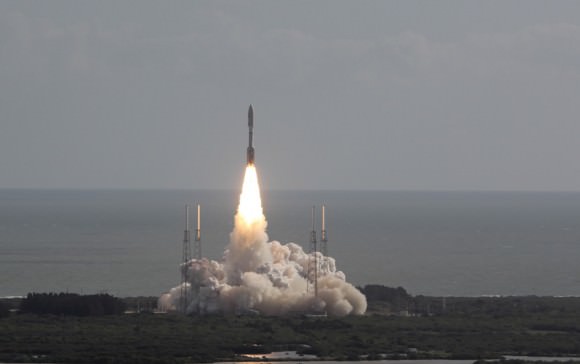
Credit: Ken Kremer – kenkremer.com
Curiosity Bores into Kimberley rock after Inspection Unveils Enticing Bumpy Textures
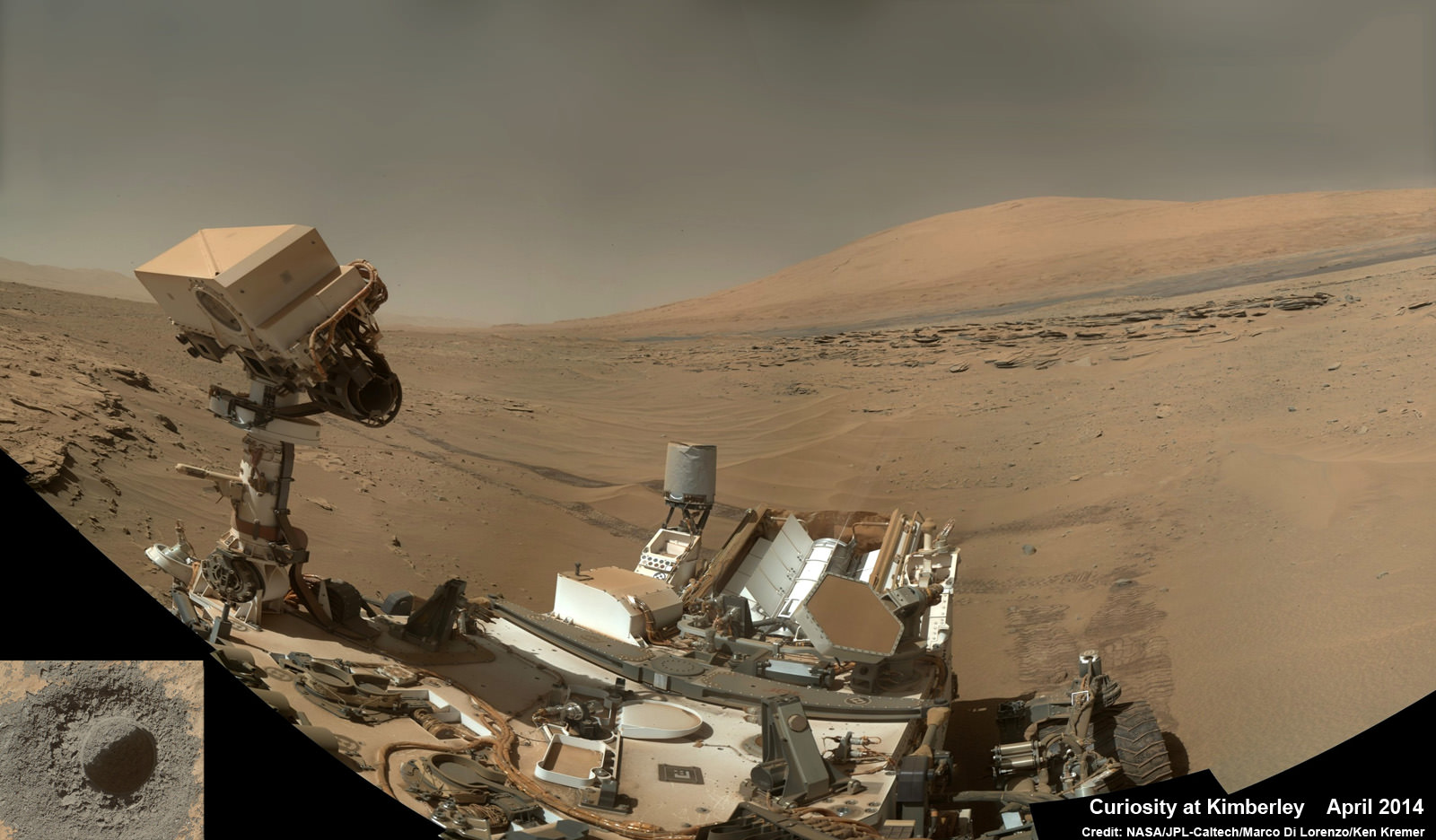
Curiosity snaps selfie at Kimberley waypoint with towering Mount Sharp backdrop on April 27, 2014 (Sol 613). Inset shows MAHLI camera image of rovers mini-drill test operation on April 29, 2014 (Sol 615) into “Windjana” rock target at Mount Remarkable butte. MAHLI color photo mosaic assembled from raw images snapped on Sol 613, April 27, 2014. Credit: NASA/JPL/MSSS/Marco Di Lorenzo/Ken Kremer – kenkremer.com
See more Curiosity photo mosaics below[/caption]
Three days ago, the burning question was “To Drill or not to Drill?”
The answer has come Fast and Furious – “Drill, Baby, Drill !”
After spending the weekend inspecting an enticing slab of sandstone rock at “Kimberley”, the team directed NASA’s Curiosity rover to bore a test hole into a Martian rock target called “Windjana” on Tuesday, April 29, Sol 615, that exhibited interesting bumpy textures. See above our illustrative “Kimberley” photo mosaic.
“A decision about full drilling is planned in coming days,” NASA JPL press officer Guy Webster told me today.
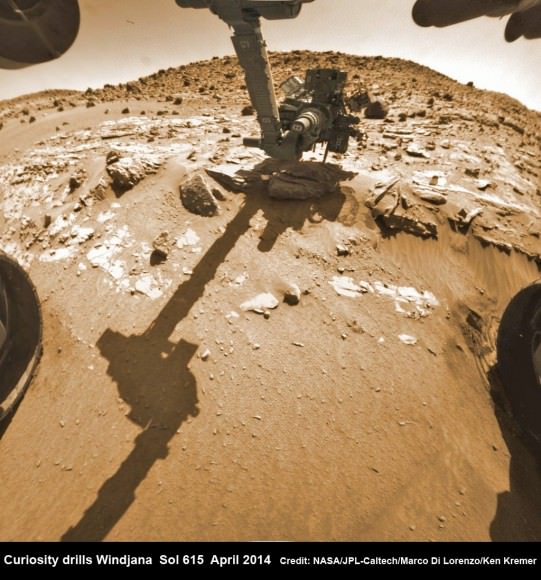
Engineers commanded Curiosity to perform the so called “mini-drill” operation at “Windjana”- as the site of the robots third drilling operation since touching down on the Red Planet back in August 2012.
The 1 ton robot drilled a test hole 0.63 inch (1.6 centimeters) in diameter and to a depth of about 0.8 inch (2 centimeters) using the hammering drill at the terminus of the robotic arm.
Windjana is an outcrop of sandstone located at the base of a Martian butte named Mount Remarkable at “The “Kimberley” waypoint – a science stopping point reached by the rover in early April 2014 along its epic trek to towering Mount Sharp, the primary destination of the mission.
See our photo mosaics illustrating Curiosity’s science activities and drilling operations on “Windjana” and roving around the “Mount Remarkable” butte at “The Kimberley Waypoint” – above and below – by the image processing team of Marco Di Lorenzo and Ken Kremer.
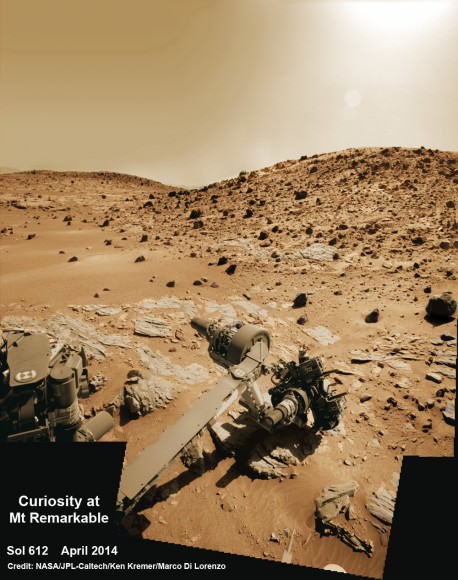
The team is evaluating the resulting hole and powdery, gray colored tailings with the arm’s high resolution MAHLI camera and other instruments to determine whether to follow up with a deep drilling operation to a depth of 2.5 inches (6.4 centimeters).
To prepare for the “mini drill” operation, Curiosity first brushed the candidate drill site off with the wire-bristle Dust Removal Tool (DRT) this past weekend, to clear away obscuring Red Planet dirt and dust hindering observations with the cameras and spectrometers.
“In the brushed spot, we can see that the rock is fine-grained, its true color is much grayer than the surface dust, and some portions of the rock are harder than others, creating the interesting bumpy textures,” said Curiosity science team member Melissa Rice of the California Institute of Technology, Pasadena., in a NASA statement
“All of these traits reinforce our interest in drilling here in order understand the chemistry of the fluids that bound these grains together to form the rock.”
“Windjana,” is named after a gorge in Western Australia.
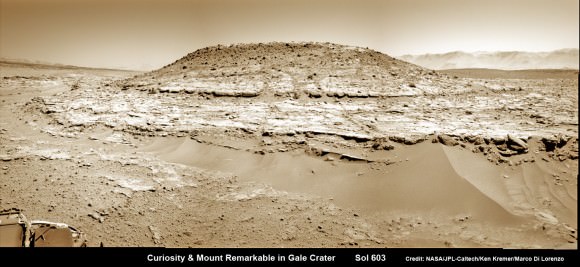
Why was Kimberley chosen as a science destination ?
“The Kimberley” has interesting, complex stratigraphy,” Curiosity Principal Investigator John Grotzinger, of the California Institute of Technology, Pasadena, told me.
If the team decides that Windjana meets the required criteria, Curiosity will bore a full depth hole into the sandstone rock, and then pulverize and filter it prior to delivery to the two onboard miniaturized chemistry labs – SAM and CheMin.
Windjana would be the first sandstone drill target, if selected. The first two drill locations at ‘John Klein’ and ‘Cumberland’ inside Yellowknife Bay were mudstone.
Curiosity departed the ancient lakebed at the Yellowknife Bay region in July 2013 where she discovered a habitable zone with the key chemical elements and a chemical energy source that could have supported microbial life billions of years ago – and thereby accomplished the primary goal of the mission.
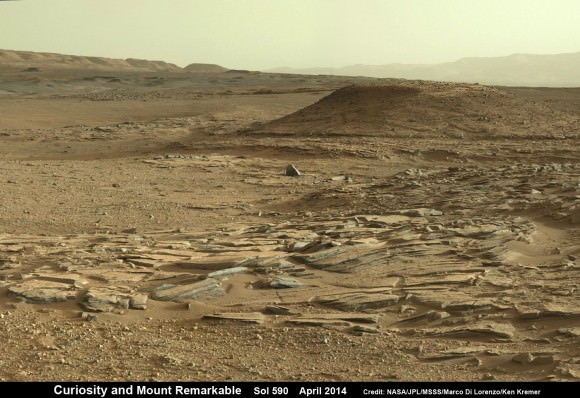
Stay tuned here for Ken’s continuing Curiosity, Opportunity, Chang’e-3, SpaceX, Orbital Sciences, LADEE, MAVEN, MOM, Mars and more planetary and human spaceflight news.
Ken Kremer
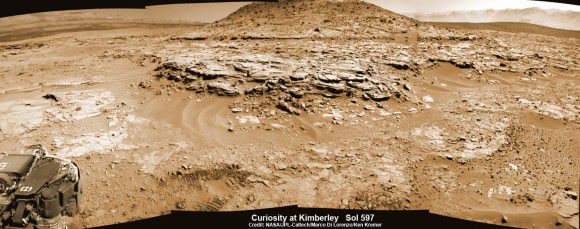
Hello From Mars! Curiosity Smiles in Her Latest “Selfie”
This is very cute — Curiosity’s latest “selfie,” a mosaic I assembled from about a dozen images acquired with the rover’s Mars Hand Lens Imager (MAHLI) instrument on April 27-28, 2014 (Sol 613), with the 5.5-km-high Mount Sharp (Aeolis Mons) rising in the background. Click the image for a high-res version.
While it’s far from a perfect image — there are plenty of discrepancies in the mosaic tiling, I admit — I really like the character it imparts to Curiosity, who almost seems to be giving a toothy (if slightly dusty) grin there on the left with her cylindrical RUHF antenna and a bit of her RTG visible in the lower center. And with almost 21 Earth-months on Mars and lots of discoveries already under her robot belt, Curiosity (and her team) certainly have plenty to smile about!
See these and all the raw images from the MSL mission here, and read more about Curiosity’s latest work in Gale Crater in Ken Kremer’s article here.
Curiosity Reaches Out to Scrutinize Next Martian Drill Target at Mount Remarkable
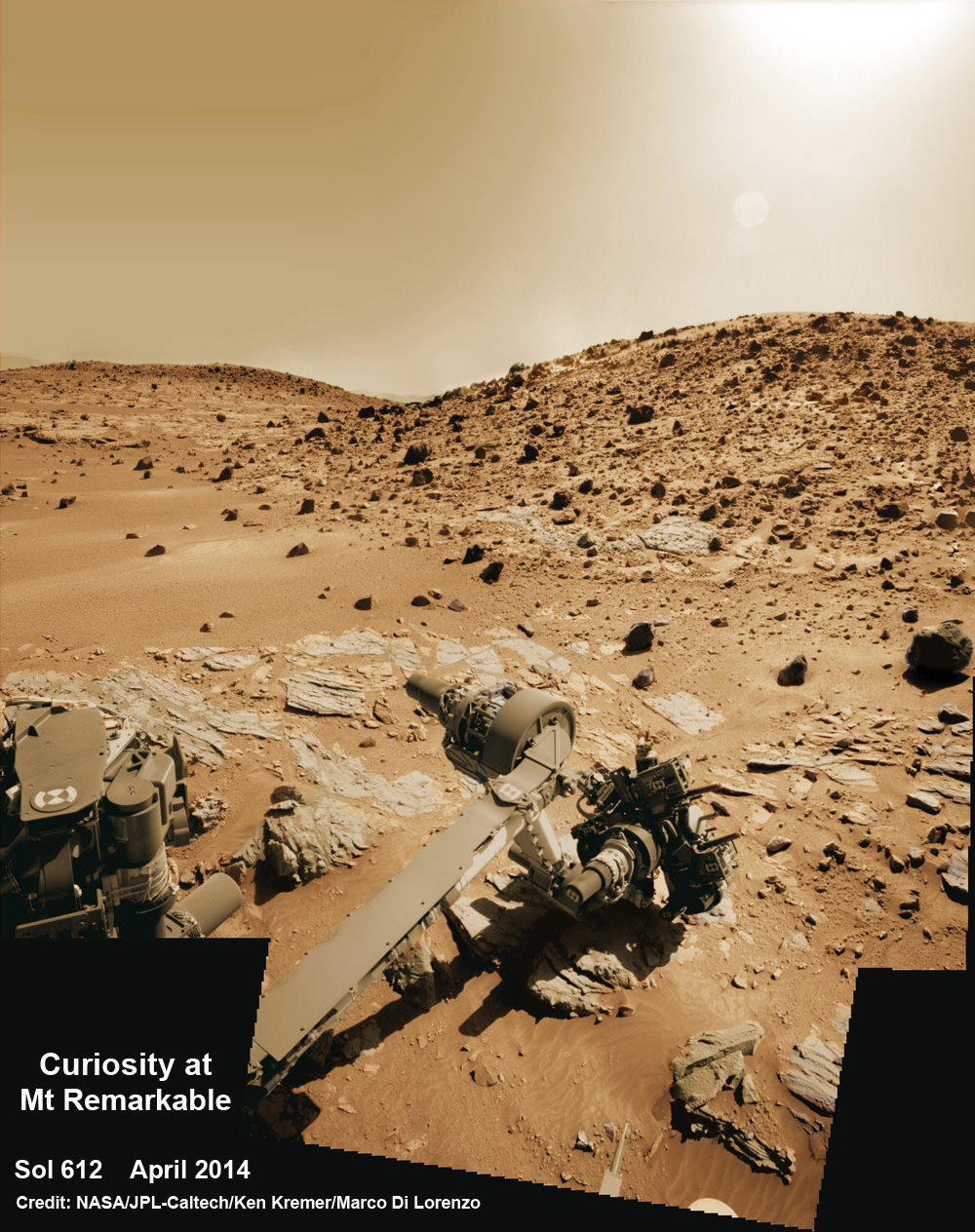
Multisol composite photo mosaic shows deployment of Curiosity rovers robotic arm and APXS X-ray spectrometer onto the ‘Winjana’ rock target at Mount Remarkable for evaluation as missions third drill target inside Gale Crater on Mars. The navcam raw images were stitched together from several Martian days up to Sol 612, April 26, 2014 and colorized. Credit: NASA/JPL-Caltech/Ken Kremer – kenkremer.com/Marco Di Lorenzo
See more Curiosity photo mosaics below[/caption]
To Drill or not to Drill?
That’s the momentous question posed by the international team of scientists and engineers who commanded NASA’s SUV sized Curiosity rover to reach out with her high tech robotic arm this weekend (Apr 25-27) and gather critical science measurements for high powered scrutiny of an outcrop on a Martian butte named Mount Remarkable.
See our multisol, composite photo mosaic – above – illustrating Curiosity’s arm in action pressing down her X-ray spectrometer on Saturday, April 26, Sol 612, at an alien rock on Mount Remarkable at the current stopping point at “The Kimberley Waypoint” along the epic trek to towering Mount Sharp.
Via a combination of laser shots, images, brushings and spectrometry the team is pondering new data streaming back daily across hundreds of millions of kilometers of interplanetary space to Earth to determine whether to bore into a sandstone slab being evaluated as the target for the missions third drilling campaign.
The team deployed the arm this weekend onto a rock target called “Windjana,” after a gorge in Western Australia.

After confirming that the 1 ton robot was in a stable position, the team commanded study observations on Saturday, Sol 612, using the APXS spectrometer and MAHLI camera on the terminus of the arm’s turret.
“The observation will document its chemical composition and morphology before drilling,” says science team member Ken Herkenoff in a mission update.
She also brushed off the potential ‘Windjana’ drill target with the wire-bristle Dust Removal Tool (DRT) to clear away obscuring Red Planet dirt and dust hindering the data collections.
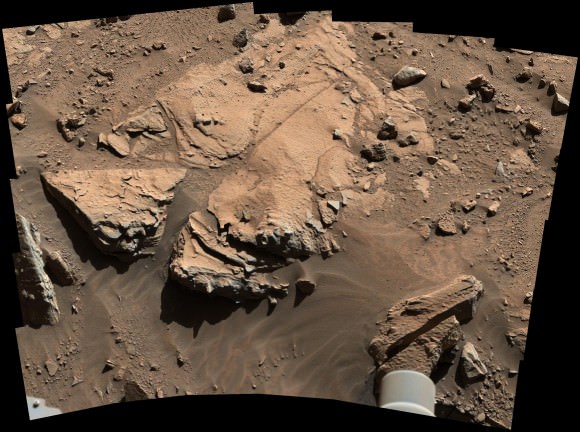
The rover is also conducting continuing remote sensing observations with the ChemCam, Mastcam and Navcam cameras mounted on the Mast.
Today, April 27, Sol 613, “MAHLI will take another selfie of the rover” according to Herkenhoff.
In early April, the six wheeled rover pulled into a scientifically enticing science destination known as “The Kimberley Waypoint” in hopes of carrying out the next drilling operation into alien Martian terrain in search of further clues about ancient Martian environments that may have been favorable for life.
“We are officially in ‘The Kimberley’ now,” Curiosity Principal Investigator John Grotzinger, of the California Institute of Technology, Pasadena, told me at that time.
Since arriving in the Kimberley region, Curiosity’s earth bound handlers have been maneuvering the 1 ton robot around to thoroughly survey destination “Kimberley” in choosing the best drill site.
Why was Kimberley chosen as a science destination ?
“The Kimberley” has interesting, complex stratigraphy,” Grotzinger told me.
If Windjana meets the required criteria, Curiosity will bore into the sandstone rock, and then pulverize and filter it prior to delivery to the two onboard miniaturized chemistry labs – SAM and CheMin.
Windjana would be the first sandstone drill target, if selected. The first two drill locations at ‘John Klein’ and ‘Cumberland’ inside Yellowknife Bay were mudstone.

Curiosity departed the ancient lakebed at the Yellowknife Bay region in July 2013 where she discovered a habitable zone with the key chemical elements and a chemical energy source that could have supported microbial life billions of years ago – and thereby accomplished the primary goal of the mission.
“We want to learn more about the wet process that turned sand deposits into sandstone here,” said Grotzinger, in a NASA statement.
“What was the composition of the fluids that bound the grains together? That aqueous chemistry is part of the habitability story we’re investigating.”
“Understanding why some sandstones in the area are harder than others also could help explain major shapes of the landscape where Curiosity is working inside Gale Crater. Erosion-resistant sandstone forms a capping layer of mesas and buttes. It could even hold hints about why Gale Crater has a large layered mountain, Mount Sharp, at its center,” NASA elaborated in the statement.
To date, Curiosity’s odometer totals 3.8 miles (6.1 kilometers) since landing inside Gale Crater on Mars in August 2012. She has taken over 143,000 images.
The sedimentary foothills of Mount Sharp, which reaches 3.4 miles (5.5 km) into the Martian sky, is the 1 ton robots ultimate destination inside Gale Crater because it holds caches of water altered minerals. Such minerals could possibly indicate locations that sustained potential Martian life forms, past or present, if they ever existed.
Curiosity has some 4 kilometers to go to reach the base of Mount Sharp sometime later this year.
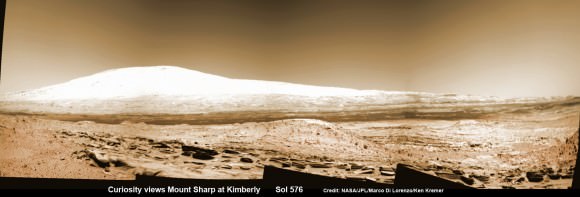
Stay tuned here for Ken’s continuing Curiosity, Opportunity, Chang’e-3, SpaceX, Orbital Sciences, LADEE, MAVEN, MOM, Mars and more planetary and human spaceflight news.

Imagine What Could Be Done With a “Penny4NASA”
If you’re reading this then you’re probably a big fan of space exploration. And while on one hand you could say that we are now living in a “golden age” of exploration, what with the ongoing missions there are around the Solar System and the new discoveries being made on an almost weekly basis about our Universe, on the other hand it seems like we are getting more and more “grounded” as human explorers, with still years to go before the first footprints are made on Mars, an ever-growing span since we last walked on the Moon, and steadily-shrinking or stagnant budgets that can’t support all the missions that DO exist — and sometimes cancel them altogether.
“We have discovered amazing places. But imagine what’s hiding where we haven’t even looked?”
In order for missions to ever get off the ground, they need to be funded. Right now NASA — still arguably the leader in space exploration among world agencies — receives a little over 0.4 percent of every U.S. tax dollar. Less than half a penny. That’s what NASA explores the Solar System with, what makes our knowledge of the Universe — from the farthest visible reaches right down to our own planet Earth — even possible. What if NASA were to receive a full one percent? A whole penny from every dollar? That’d still be only a quarter of what NASA worked with to put men on the Moon in 1969, but it’d be more than double what it gets now.
A penny for NASA… this is the goal of Penny4NASA.org, an outreach group that strives to increase the funding — if just by a little — of the world’s most accomplished, inspirational, and powerful space exploration administration. (Before… you know, it isn’t.)
The video above was created for Penny4NASA by artist and animator Brad Goodspeed, and reminds us of what NASA has achieved in its 50-year history, of what its goals are (or at least should be) and, unfortunately, why many of them have remained unattained. NASA needs support — our support — or else its candles will stay unlit and our windows and doors to the Universe will slowly but surely close.
How can you help? Well for one thing, stay excited about space and science (and get others excited too!) Interest is the key to making sure people don’t lose sight of what’s happening in the field; you might be surprised to hear the misinformation that’s been passed around. (No, NASA isn’t “dead.”) And let your policy-makers know that space exploration and the investment in technology and innovation that goes along with it is important to you — the Planetary Society has a convenient page where you can find links to write to your state representative here. And finally you can support groups like Penny4NASA, made up of enthusiastic young professionals who want to see our nation’s past successes in space exploration continued into their future.
“America is fading right now. Nobody’s dreaming about tomorrow anymore. NASA knows how to dream about tomorrow — if the funding can accommodate it, if the funding can empower it.”
– Neil deGrasse Tyson
Want more inspiration? Read this excerpt from Neil deGrasse Tyson’s Space Chronicles on TheWeek.com here.
Video credit: Brad Goodspeed/Penny4NASA.org
Easter Sunday Space Station Rendezvous and Berthing for SpaceX Dragon Freighter Successful
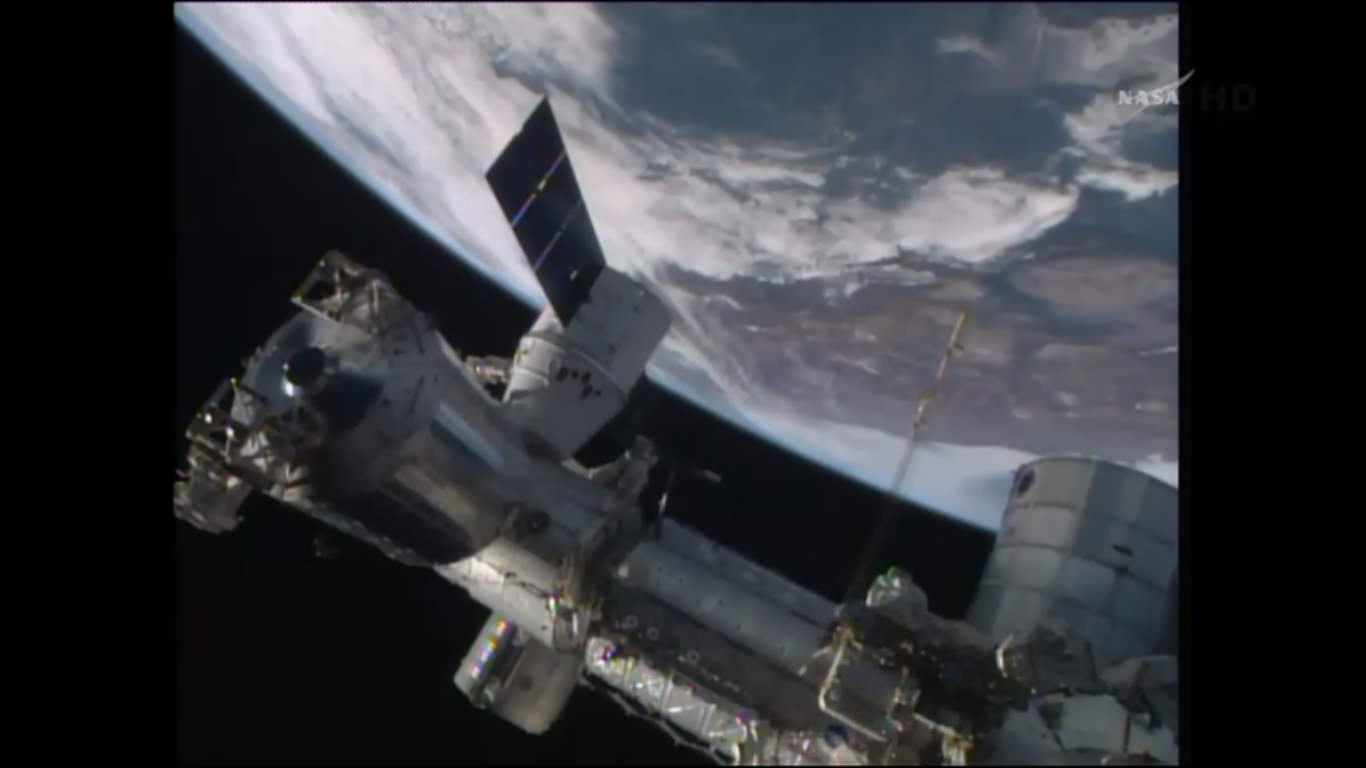
The SpaceX 3 Dragon commercial cargo freighter successfully arrived at the International Space Station (ISS) on Easter Sunday morning, April 20, as planned and was deftly captured by Expedition 39 Commander Koichi Wakata at 7:15 a.m. EDT at the controls of the Canadian built robotic arm.
The next step due shortly is berthing of Dragon at the Earth facing port of the Harmony module at approximately 9:30 a.m. EDT.
Berthing was officially completed at 10:06 a.m. EDT while the massive complex was soaring 260 miles above Brazil.
This story is being updated as events unfold. The mission is the company’s third cargo delivery flight to the station.
The Dragon vehicle loaded with nearly 2.5 tons of science experiments and supplies moved ever so slowly closely to within grappling distance – dramatically backdropped with gorgeous and ever changing scenery of our Home Planet sliding below.
The million pound orbiting lab complex and free flying SpaceX Dragon were soaring some 260 miles above Egypt and the Nile River as the 57 foot long robotic arm grappled the resupply ship.
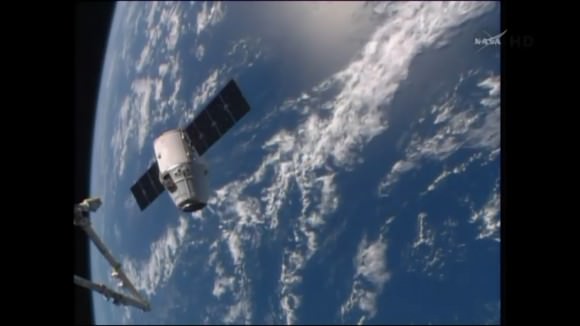
Dragon was approximately 30 feet (10 meters) away from the stations hull at the time of capture.
Wakata, of the Japan Aerospace Exploration Agency, was assisted by NASA astronaut Rick Mastracchio, while both were working from inside the 7 windowed Cupola robotics work station. Newly arrived NASA astronaut Steve Swanson observed the proceedings with a big smile.
“Congratulations to the entire ops team for the successful launch, rendezvous and capture of Dragon,” Wakata radioed mission control moments after the successful grapple.
“Great work catching the Dragon, enabling fantastic science,” radioed Capcom Steve Fisher from NASA Houston Mission Control.
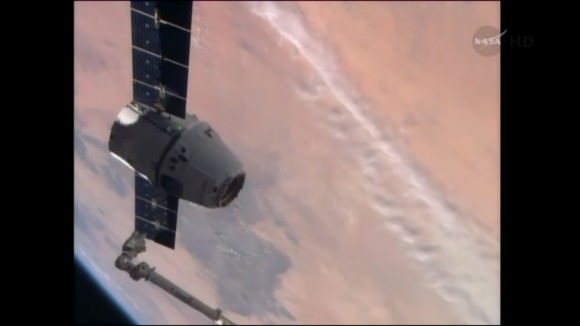
Cheers and celebrations erupted at SpaceX Mission Control at the firms headquarters in Hawthorne, Calif.
Dragon arrived this morning following Friday afternoons, Apr 18, spectacular blastoff from Cape Canaveral, Fla, atop an upgraded SpaceX Falcon 9 booster.
A two day orbital chase ensued with a series of critical engine burns targeting the ISS for Easter Sunday’s rendezvous and docking activities.
Rick Mastracchio was at the controls for the actual berthing and latching in place at Harmony with Dragon’s Common Berthing Mechanism (CBM).
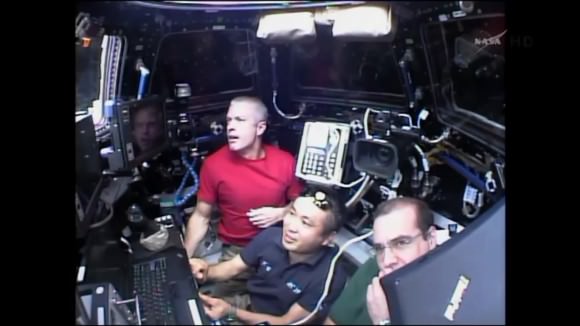
The berthing process started at about 9:30 a.m. EDT.
4 latches were driven for 1st stage of capture. Followed by all 16 bolts and latches in total during second stage capture to firmly hold Dragon in place.
The crew and mission control concluded the berthing procedure at 10:06 a.m. EDT flying over Brazil.
The next step is for the crew to pressurize the vestibule connecting Dragon to station.
Hatch opening is set to take place on Monday morning.
It’s a busy week ahead for the six person international crew representing the US, Russia and Japan.
A Russian Progress departs on Wednesday followed by the 2 person US spacewalk to replace the failed MDM unit.
Dragon will remain attached to the station until May 18.
This story is being updated. Check back.
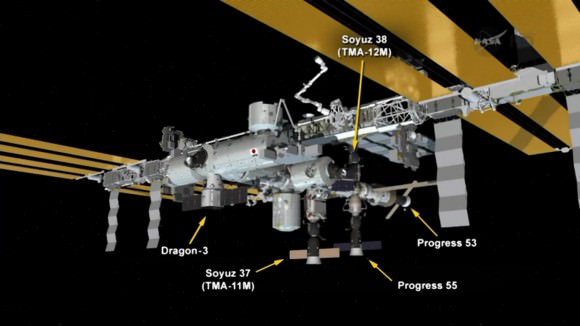
The SpaceX-3 mission marks the company’s third operational resupply mission to the ISS under a $1.6 Billion contract with NASA to deliver 20,000 kg (44,000 pounds) of cargo to the ISS during a dozen Dragon cargo spacecraft flights through 2016.
There are over 150 science experiments loaded aboard the Dragon capsule for research to be conducted by the crews of ISS Expeditions 39 and 40.
This unmanned SpaceX mission dubbed CRS-3 mission will deliver some 5000 pounds of science experiments, a pair of hi tech legs for Robonaut 2, a high definition Earth observing imaging camera suite (HDEV), a laser optical communications experiment (OPALS) and essential gear, the VEGGIE lettuce growing experiment, spare parts, crew provisions, food, clothing and supplies to the six person crews living and working aboard the ISS soaring in low Earth orbit under NASA’s Commercial Resupply Services (CRS) contract.
NASA TV coverage of the Easter Sunday grappling process began at 5:45 a.m. EDT with berthing coverage beginning at 9:30 a.m. EDT: http://www.nasa.gov/ntv
Stay tuned here for Ken’s continuing SpaceX, Orbital Sciences, commercial space, Orion, Chang’e-3, LADEE, Mars rover, MAVEN, MOM and more planetary and human spaceflight news.
Screenshots by Rob v. Mackelenbergh.
SpaceX Makes Strides Towards 1st Stage Falcon Rocket Recovery during Space Station Launch
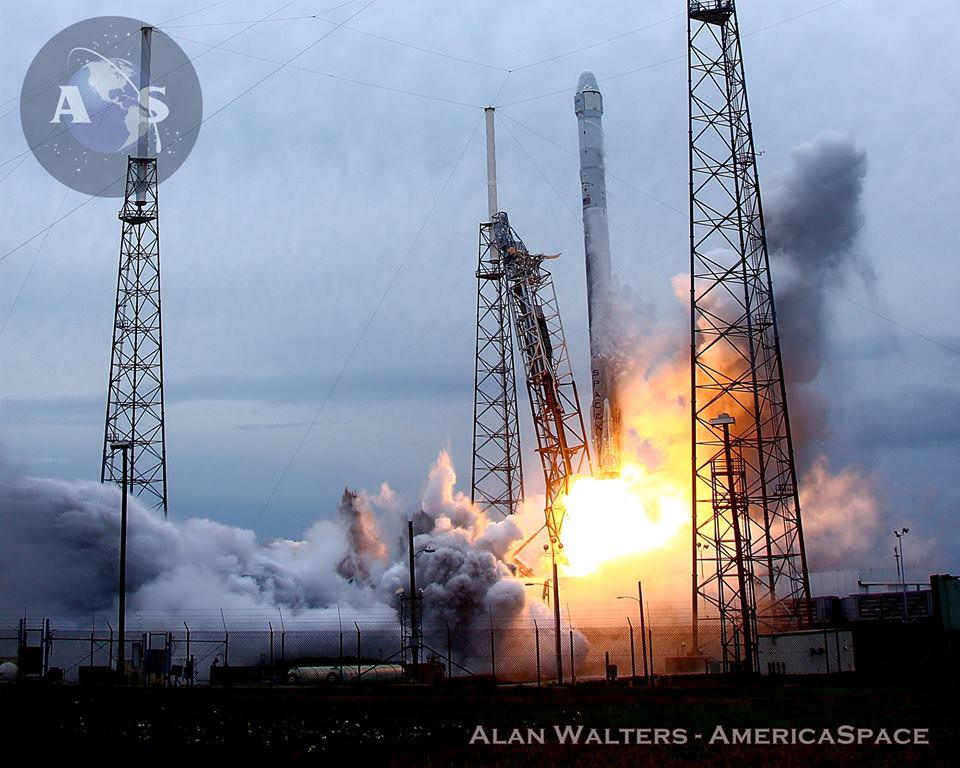
Blastoff of SpaceX Falcon 9 rocket from Cape Canaveral Air Force Station in Florida on April 18, 2014. Credit: Alan Walters/AmericaSpace
Story updated[/caption]
The powerful SpaceX Falcon 9 rocket that launched successfully on a cargo delivery run for NASA bound for the Space Station on Friday, April 18, from Cape Canaveral, Fla, also had a key secondary objective for the company aimed at experimenting with eventually recovering the rockets first stage via the use of landing legs and leading to the boosters refurbishment and reuse further down the road.
Marking a first of its kind test, this 20 story tall commercial Falcon 9 rocket was equipped with a quartet of landing legs to test controlled soft landing techniques first in the ocean and then back on solid ground at some later date this year or next – by reigniting the 1st stage engines for a guided touchdown.
The 12 foot diameter Falcon 9 rocket would sprout the legs just prior to water impact for the controlled soft landing in the Atlantic Ocean, guided by SpaceX engineers.
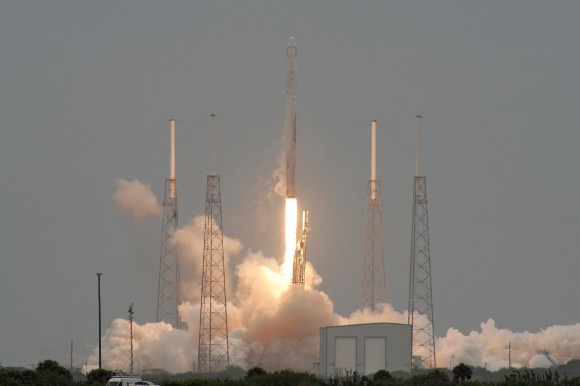
Prior to the launch SpaceX managers were careful not to raise expectations.
“The entire recovery of the first stage is completely experimental,” said Hans Koenigsmann, SpaceX vice president of mission assurance. “It has nothing to do with the primary mission.”
He estimated the odds of successfully retrieving an intact booster at merely 30 or 40 percent.
Following Friday’s blastoff, SpaceX reported they made significant strides towards that goal of a 1st stage recovery.
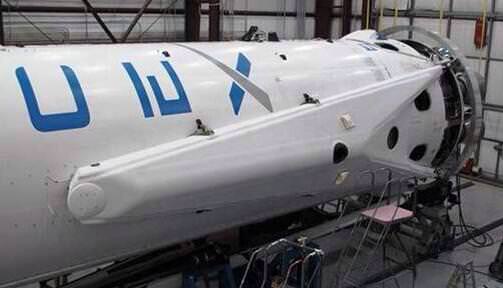
SpaceX engineers had preprogrammed the spent first stage to relight several Merlin 1 D engines after completing the boost phase and stage seperation to stabilize it, reduce its roll rate and then gradually lower its altitude back down to the Atlantic Ocean’s surface for a soft landing attempt and later possible recovery by retrieval ships.
All these critical steps seemed to go fairly well in initial reports that are subject to change.
SpaceX CEO and founder Elon Musk reported at a post launch briefing and later tweeted further updates that the Falcon 9 first stage actually made a good water landing despite rough seas, with waves swelling at least six feet.
“Roll rate close to zero (v important!).”
“Data upload from tracking plane shows landing in Atlantic was good! Several boats enroute through heavy seas,” Musk tweeted.
Furthermore he reported that the 1st stage survived the ocean touchdown.
“Flight computers continued transmitting for 8 seconds after reaching the water. Stopped when booster went horizontal.”
Because of the high waves, the recovery boats had difficulty reaching the booster in the recovery area located some two hundred miles off shore from Cape Canaveral.
Several previous attempts by SpaceX to recover the first stage via parachutes and thrusters were not successful. So SpaceX adopted this new approach with the landing legs and 1st stage Merlin 1 D engines.
Further details will be proved when they become available.
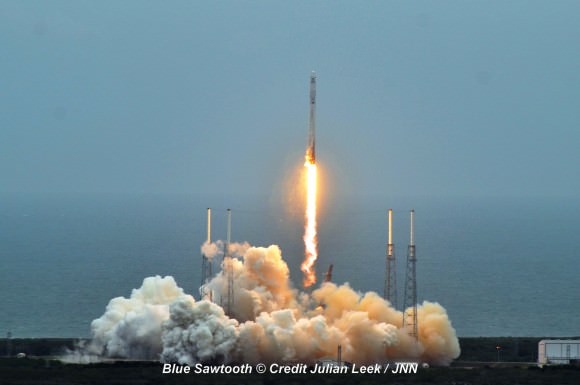
The attachment of the 25 foot long 1st stage landing legs to SpaceX’s next-generation Falcon 9 rocket for ocean recovery counts as a major step towards the firm’s future goal of building a fully reusable rocket and dramatically lowering launch costs compared to expendable boosters.
The eventual goal is to accomplish a successful first stage touchdown by the landing legs on solid ground back somewhere near on Cape Canaveral, Florida.
Musk said that SpaceX is still working out the details on finding a suitable landing location with NASA and the US Air Force.
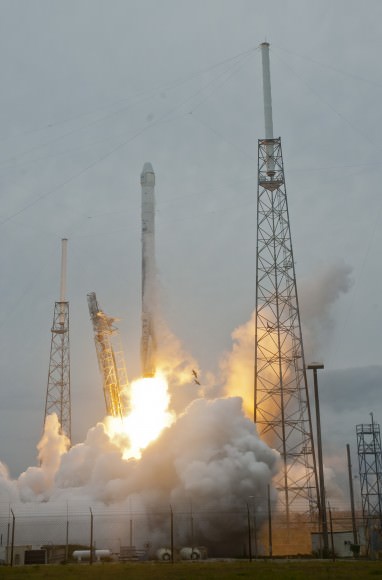
Extensive work and testing remains to develop and refine the technology before a land landing will be attempted by the company, says Musk.
It will be left to future missions to accomplish a successful first stage touchdown by the landing legs back on solid ground back through a series of ramped up rocket tests at Cape Canaveral, Florida.
“Even though we probably won’t get the stage back, I think we’re really starting to connect the dots of what’s needed,” Musk said at the briefing.
“There are only a few more dots that need to be there to have it all work. I think we’ve got a decent chance of bringing a stage back this year, which would be wonderful.”
Overall Musk was very pleased with the performance of the rocket and the landing leg test.
“I would consider it a success in the sense that we were able to control the boost stage to a zero roll rate, which is previously what has destroyed the stage, an uncontrolled roll, where the on-board nitrogen thrusters weren’t able to control the aerodynamic torque and spun up.”
“This time, with more powerful thrusters and more nitrogen propellant, we were able to null the roll rates.”
“I’m feeling pretty excited,” Musk stated. “This is a happy day. Most important of all is that we did a good job for NASA.”
This extra powerful new version of the Falcon 9 dubbed v1.1 is powered by a cluster of nine of SpaceX’s new Merlin 1D engines that are about 50% more powerful compared to the standard Merlin 1C engines. The nine Merlin 1D engines 1.3 million pounds of thrust at sea level rises to 1.5 million pounds as the rocket climbs to orbit.
Therefore the upgraded Falcon 9 can boost a much heavier cargo load to the ISS, low Earth orbit, geostationary orbit and beyond.
Indeed Dragon is loaded with nearly 5000 pounds of cargo, about double the weight carried previously.
If all goes well, Dragon will reach the ISS early on Easter Sunday morning after a two day orbital chase.
Station crew members Rick Mastracchio and Steven Swanson will grapple the Dragon cargo freighter with the 57 foot long Canadarm2 on Easter Sunday at about 7:14 a.m. and then berth it at the Earth-facing port of the Harmony module.
NASA TV coverage of the Easter Sunday grappling process will begin at 5:45 a.m. with berthing coverage beginning at 9:30 a.m. : http://www.nasa.gov/ntv
Stay tuned here for Ken’s continuing SpaceX, Orbital Sciences, commercial space, Orion, Chang’e-3, LADEE, Mars rover, MAVEN, MOM and more planetary and human spaceflight news.
Ken Kremer
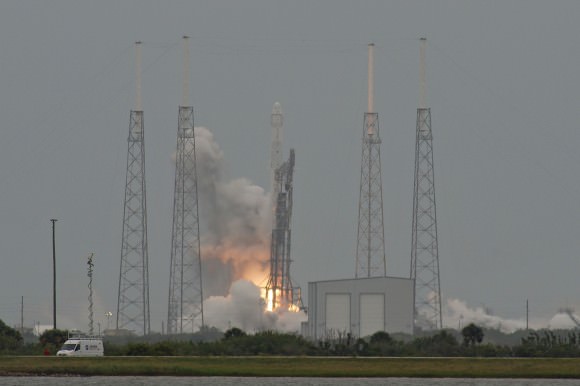
SpaceX Commercial Dragon Resupply Ship Thunders to Space Bound for ISS and Easter Sunday Berthing – Photo Gallery
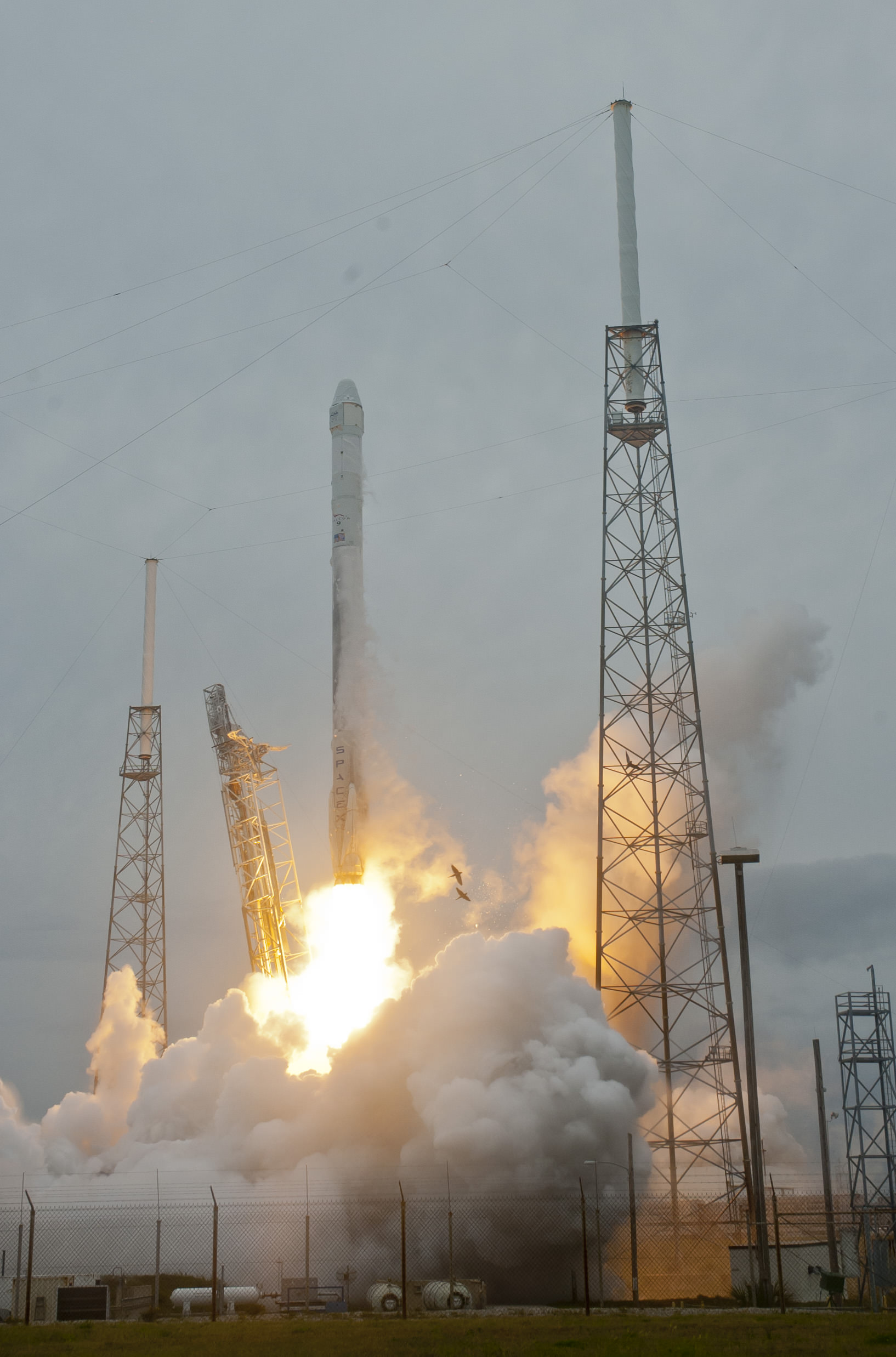
SpaceX Falcon 9 rocket and Dragon resupply ship launch from the Cape Canaveral Air Force Station in Florida on April 18, 2014. Credit: Jeff Seibert/Wired4Space
See expanding launch gallery below[/caption]
A mighty SpaceX rocket carrying the firms commercial Dragon resupply ship loaded with nearly 2.5 tons of NASA science instruments and critical supplies thundered to space this afternoon on a two day journey bound for the International Space Station.
The Dragon vessel launched atop the 20 story tall, upgraded Falcon 9 rocket from Space Launch Complex 40 at Cape Canaveral Air Force Station in Florida precisely on time at 3:25 p.m. EDT (1925 GMT), Friday, April 18.
“I want to congratulate SpaceX. Everyone did a great job” said William Gerstenmaier, NASA associate administrator for human exploration and operations, at a post launch briefing at the Kennedy Space Center press site.
“The SpaceX team went the extra mile to get everything ready for an on time launch.”
The spectacular blastoff went off without a hitch despite a poor weather prognosis in the morning that brightened considerably in the final hours leading up to the afternnon liftoff.
“Everything went well with the ascent,” said SpaceX CEO and founder Elon Muck at the briefing.
“I’m pretty excited. We did a good gob for our NASA customer and that’s very important,” Musk added.
The on time blastoff sets the stage for an Easter Sunday, April 20, rendezvous and berthing of the Dragon resupply spacecraft at the massive orbiting outpost packed with a striking variety of science experiments and needed supplies for the six person crew.
Station crew members Rick Mastracchio and Steven Swanson will grapple the Dragon cargo freighter with the 57 foot long Canadarm2 on Easter Sunday at about 7:14 a.m. if all goes well and then berth it at the Earth-facing port of the Harmony module.
The SpaceX-3 mission marks the company’s third resupply mission to the ISS under a $1.6 Billion contract with NASA to deliver 20,000 kg (44,000 pounds) of cargo to the ISS during a dozen Dragon cargo spacecraft flights through 2016.
There are over 150 science experiments loaded aboard the Dragon capsule for research to be conducted by the crews of ISS Expeditions 39 and 40.
“SpaceX is delivering important research experiments and cargo to the space station,” said Gerstenmaier.
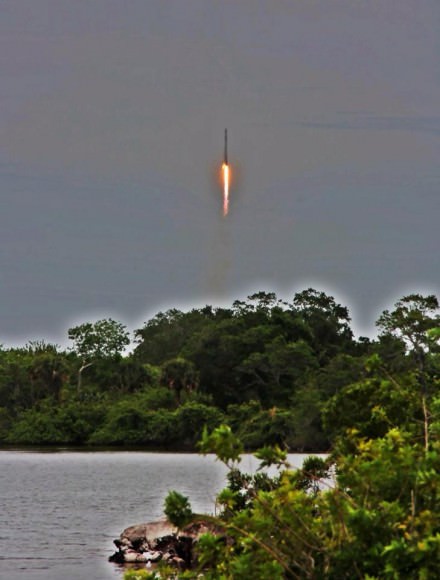
“The diversity and number of new experiments is phenomenal. The investigations aboard Dragon will help us improve our understanding of how humans adapt to living in space for long periods of time and help us develop technologies that will enable deep space exploration.”
This unmanned SpaceX mission dubbed CRS-3 mission will deliver some 5000 pounds of science experiments, a pair of hi tech legs for Robonaut 2, a high definition imaging camera suite, an optical communications experiment (OPALS) and essential gear, the VEGGIE lettuce growing experiment, spare parts, crew provisions, food, clothing and supplies to the six person crews living and working aboard the ISS soaring in low Earth orbit under NASA’s Commercial Resupply Services (CRS) contract.
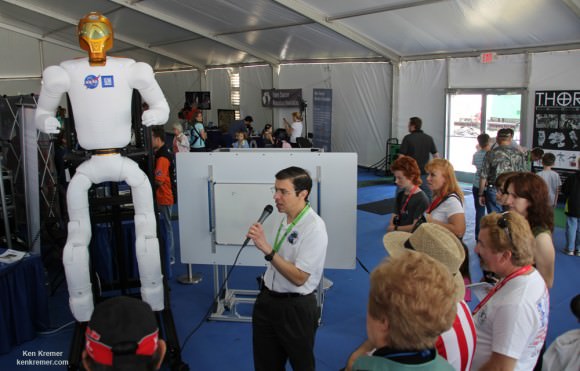
To date SpaceX had completed two operational cargo resupply missions and a test flight. The last flight dubbed CRS-2 blasted off a year ago on March 1, 2013 atop the initial version of the Falcon 9 rocket.
The next launch of Orbital Sciences Antares/Cygnus commercial rocket to the ISS from NASA Wallops, VA, was tentatively slated for May 6. But the target date will now slip to into mid-June since it can’t arrive until the Dragon departs.
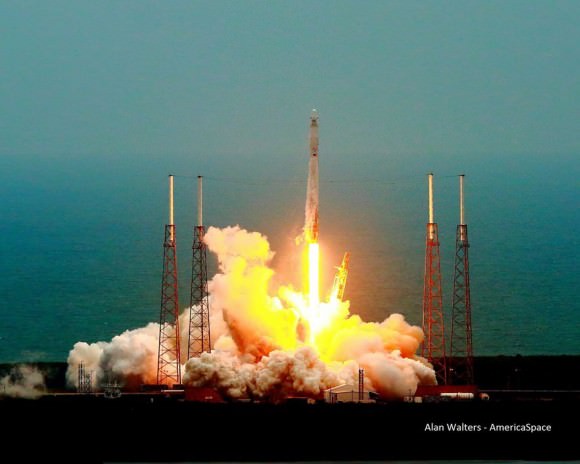
Both the Dragon and Antares dock at the same port on the Harmony module at the end of the station.
This extra powerful new version of the Falcon 9 dubbed v1.1 is powered by a cluster of nine of SpaceX’s new Merlin 1D engines that are about 50% more powerful compared to the standard Merlin 1C engines. The nine Merlin 1D engines 1.3 million pounds of thrust at sea level rises to 1.5 million pounds as the rocket climbs to orbit
Stay tuned here for Ken’s continuing SpaceX, Orbital Sciences, commercial space, Orion, Chang’e-3, LADEE, Mars rover, MAVEN, MOM and more planetary and human spaceflight news.
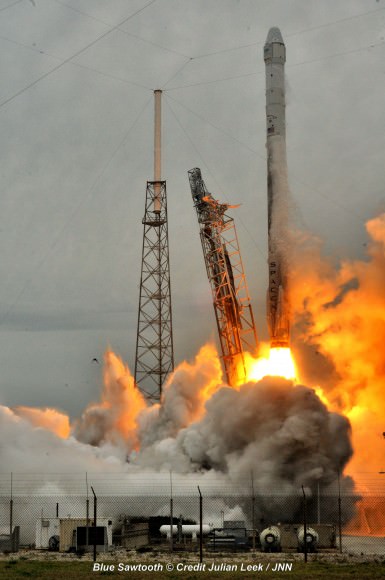
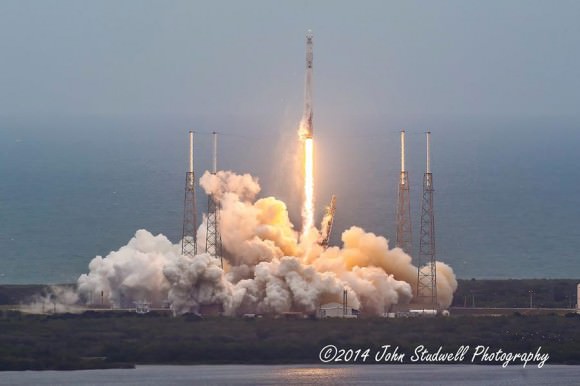
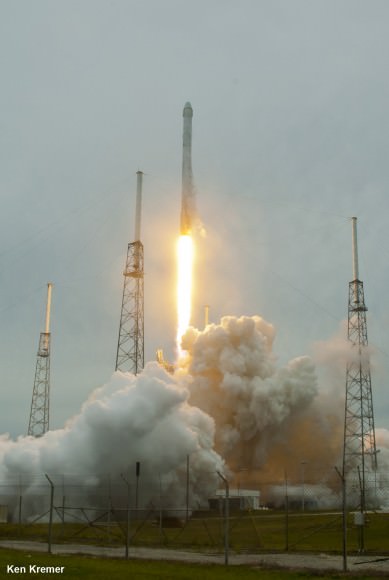
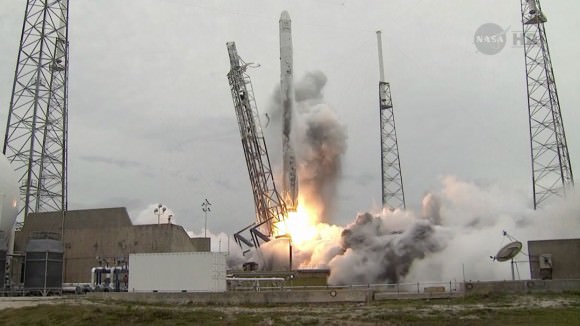
Weekly Space Hangout – April 18, 2014: Another Earth, Dragon Launch, LADEE Impact
Host: Fraser Cain
Guests: Casey Dreier, Brian Koberlein, Jason Major, Sondy Springmann, David Dickinson
Continue reading “Weekly Space Hangout – April 18, 2014: Another Earth, Dragon Launch, LADEE Impact”

